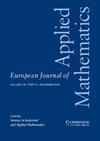多孔介质中蒸发锋运动的均匀化模型
IF 1.1
4区 数学
Q1 MATHEMATICS, APPLIED
引用次数: 1
摘要
多孔介质中的蒸发是一个多尺度和界面驱动的过程,因为孔隙中蒸发界面的相变产生了蒸汽流,并且依赖于蒸汽通过多孔介质的输送。虽然多孔介质中流动和化学输运的均质模型可以有效地模拟多尺度过程,但尚不清楚多尺度效应如何影响这些均质模型所需的界面条件。在本文中,我们推导了一个均匀化模型,包括有效的界面条件,蒸发锋通过多孔介质的运动,使用均匀化和边界层分析相结合。这一分析扩展了以前对纯扩散问题的研究,使之包括气体流动和物质的顺向扩散输运。我们研究了描述蒸发化学过程的不同微尺度模型对均质界面条件的影响。特别地,我们确定了一个新的有效参数$\mathcal{L}$,即平均微尺度界面长度,它改变了均匀化模型中的有效蒸发速率。与多孔介质的有效扩散率和渗透率一样,$\mathcal{L}$可以通过在微观尺度上求解周期细胞问题来求得。我们还表明,界面化学的不同微尺度模型导致界面上和界面附近的细微尺度行为根本不同。本文章由计算机程序翻译,如有差异,请以英文原文为准。
A homogenised model for the motion of evaporating fronts in porous media
Evaporation within porous media is both a multiscale and interface-driven process, since the phase change at the evaporating interfaces within the pores generates a vapour flow and depends on the transport of vapour through the porous medium. While homogenised models of flow and chemical transport in porous media allow multiscale processes to be modelled efficiently, it is not clear how the multiscale effects impact the interface conditions required for these homogenised models. In this paper, we derive a homogenised model, including effective interface conditions, for the motion of an evaporation front through a porous medium, using a combined homogenisation and boundary layer analysis. This analysis extends previous work for a purely diffusive problem to include both gas flow and the advective–diffusive transport of material. We investigate the effect that different microscale models describing the chemistry of the evaporation have on the homogenised interface conditions. In particular, we identify a new effective parameter,
$\mathcal{L}$
, the average microscale interface length, which modifies the effective evaporation rate in the homogenised model. Like the effective diffusivity and permeability of a porous medium,
$\mathcal{L}$
may be found by solving a periodic cell problem on the microscale. We also show that the different microscale models of the interface chemistry result in fundamentally different fine-scale behaviour at, and near, the interface.
求助全文
通过发布文献求助,成功后即可免费获取论文全文。
去求助
来源期刊
CiteScore
4.70
自引率
0.00%
发文量
31
审稿时长
>12 weeks
期刊介绍:
Since 2008 EJAM surveys have been expanded to cover Applied and Industrial Mathematics. Coverage of the journal has been strengthened in probabilistic applications, while still focusing on those areas of applied mathematics inspired by real-world applications, and at the same time fostering the development of theoretical methods with a broad range of applicability. Survey papers contain reviews of emerging areas of mathematics, either in core areas or with relevance to users in industry and other disciplines. Research papers may be in any area of applied mathematics, with special emphasis on new mathematical ideas, relevant to modelling and analysis in modern science and technology, and the development of interesting mathematical methods of wide applicability.

 求助内容:
求助内容: 应助结果提醒方式:
应助结果提醒方式:


